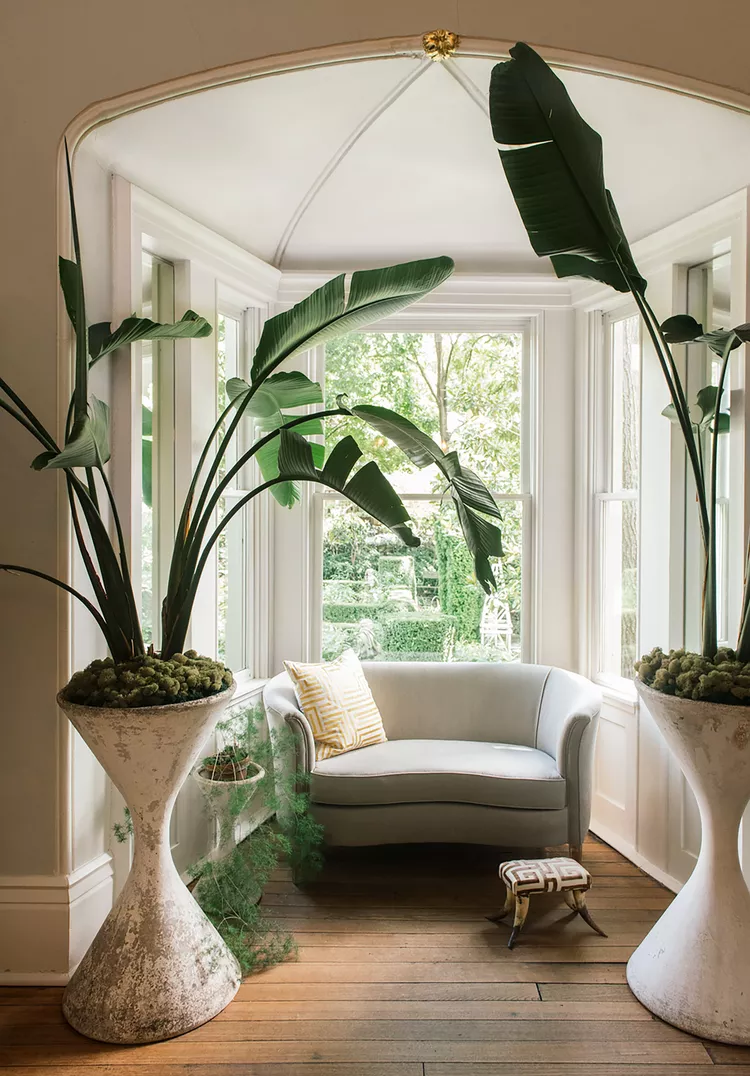Bringing large indoor plants into your home puts your plant parent status on a whole new level. Big, bold houseplants with oversized leaves are also the perfect way to embrace biophilic design and the nature-based decor trend that are everywhere right now. All that beautiful, leafy growth can't help but add life and lushness to a room. Find the best large leaf indoor plant for your space with this list of options that offer fabulous foliage on a grand scale.
Bird of Paradise
Also known as Strelitzia reginae, this large indoor plant has long, glossy, banana-like leaves. Native to South Africa, it thrives in warmer temperatures between 60-80°F. Keep bird-of-paradise away from heating and cooling vents to keep it from drying out. Avoid frequent repotting because this can delay blooming up to two years. This beautiful plant is mildly toxic to cats and dogs so it's best to keep your furry friends away from it.
Size: 5 feet tall
Light: Bright, direct sunlight
Water: From spring through fall, soil should be kept moist. During winter, allow the top two inches of soil to dry out before giving it another drink.
Monstera
Monstera deliciosa is coveted for its huge, interestingly shaped leaves. This Insta-famous tropical plant is native to Southern Mexico and Central America. It does best in environments that are 65-90°F. According to the ASPCA, monstera can be irritating to pets who sample a leaf or two, so you may want to keep the plant out of reach.
Size: Up to 30 feet tall.
Light: Bright, indirect light, but can tolerate low light.
Water: While a monstera can tolerate semi-dry conditions, it should be watered enough so that the soil does not completely dry out.
Elephant Ear
For the plant parent who likes to fuss over their green family, elephant ear (Alocasia spp.) requires moderate care. It does best in humid conditions, so a well-lit bathroom is a great spot for this plant to live. Make sure to also give its huge leaves a good dusting once in a while and check the undersides for tiny webs that indicate spider mites. This plant is best kept away from furry family members.
Size: Its leaves can grow up to 18 inches long.
Light: Bright indirect light.
Water: Wait until the top three inches of the soil are dry before adding water.
Peace Lily
Peace lily is a tropical blooming plant native to South America. It features broad, dark green leaves and fragrant white flowers. Some varieties have variegated leaves. Peace lily will bloom more if it receives more light. It's best to keep this plant away from pets.
Size: Up to 4 feet tall.
Light: Bright, indirect light, but can tolerate lower light levels.
Water: Add water once a week or when the top inch of soil feels dry.
Croton
This pretty big-leaf houseplant grows multicolored leaves in red, green, and yellow. While it can grow successfully outdoors in warm regions, it can also grow well indoors, as long as it has enough light. Croton thrives in a warm, humid environment and should be brought indoors for the winter when the temperature outside goes below 50°F. This plant will drop its leaves if the temperature is too cool, or if it experiences drafts and low humidity. All parts of this plant are toxic to pets, so it’s best to keep it out of reach of furry friends.
Size: Up to five feet.
Light: Bright, indirect light or dappled shade.
Water: Keep the soil consistently moist.
Dieffenbachia
With its large cream, yellow, and green leaves, this tropical plant from the West Indies will brighten up just about any dim corner. Also known as dumb cane, dieffenbachia contains chemicals that can temporarily paralyze your voice box, hence the name (it can strike you dumb). It can similarly affect pets, so you may want to keep this plant out of their reach. It will thrive in a bathroom because it prefers high humidity.
Size: Up to 10 feet tall.
Light: Bright, indirect light is best, but it will tolerate lower light situations.
Water: Provide a weekly watering.
Banana Plant
This big beauty thrives in warm environments ranging from 75 to 95°F. As a tropical native, banana plants also love high humidity. Look for dwarf types for growing indoors. While it will add natural beauty to any space, banana plants will not produce fruit when kept indoors. This plant is safe for those with pets at home.
Size: Up to 30 feet tall, depending upon the variety.
Light: Bright, direct light for a minimum of six hours of per day. Rotate the plant weekly to help all sides of the plant get exposure. Some varieties have leaves that can burn easily, so try situating it where sunlight gets filtered through a sheer curtain.
Water: Consistently moist soil, but not soggy.
Majesty Palm
This houseplant stands tall with its feathery fronds, requires little maintenance, and will add tropical flair to a room. Majesty palm is native to Madagascar and prefers warm, humid conditions. It's safe for pets.
Size: 4-6 feet indoors.
Light: Bright, indirect sunlight.
Water: Add water weekly, or when the top two inches of the soil is dry.
Fiddle Leaf Fig
While it can be a little temperamental, fiddle leaf fig will thrive indoors if cared for correctly. As a tropical native, it prefers warm and humid conditions. While the fiddle leaf fig makes a beautiful big houseplant, it's best to keep it away from furry friends as it can be toxic to cats and dogs.
Size: Up to 10 feet indoors.
Light: Bright, indirect light near a sunny window.
Water: When the soil is dry to the touch, water thoroughly.




















